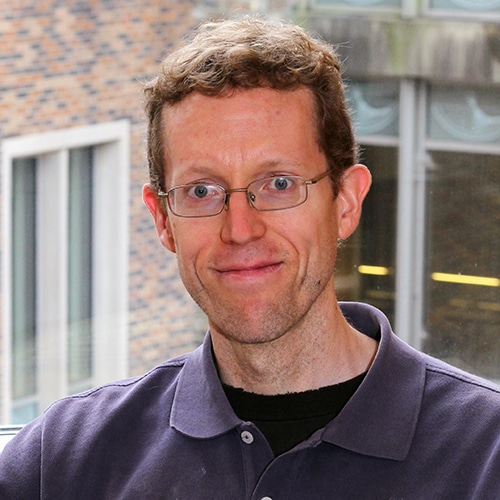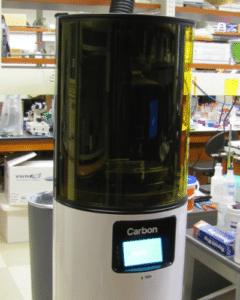
Research Facilities

Duke provides faculty and students with prototyping and testing resources typically found only at far larger institutions.
Plus, in Duke’s nano-tech resource SMiF, materials researchers from universities and industry can access advanced cleanroom fabrication, characterization and imaging.
Prototyping
-
 The Foundry in Gross Hall
The Foundry in Gross HallThe 3D Systems ProX DMP320 performs high-quality direct metal printing via sintering — a laser-guided, layer-by-layer additive powder melting process.
Features a 275 x 275 x 420 mm build area, and is typically set up for printing in titanium.
Located in the engineering school’s own dedicated maker space, The Foundry.
-
 Polymer Printing Lab, Fitzpatrick Center
Polymer Printing Lab, Fitzpatrick CenterThe M1 by Carbon 3D is an additive printer that uses polymers to produce parts with properties and finishes similar to injection molding.
Employs UV-curable resins which include prototyping (similar to SLA with custom coloring), rigid polyurethane, flexible polyurethane, elastomeric polyurethane and cyanate ester.
-
 Prototype and Instrumentation Lab, Hudson Hall
Prototype and Instrumentation Lab, Hudson HallThe Stratasys Dimension 1200es and Fortus 250 are fused deposition modeling (FDM) printers.
Reliable and repeatable, these printers build parts with ABS plastic in a 10 x 10 x 10-inch build area to a minimum resolution of 0.007 inch.
-
Student Machine Shop, 008 Telcom Building
A team of professional toolmakers teach a compulsory safety course and oversee a hands-on student shop equipped with computer-controlled machine tools. The facility is available to students to complete course work requiring milling, turning, shaping, drilling and cutting.
Tools include:
- Four CNC 3-axis mills
- Two CNC 2-axis manual mills
- Three CNC lathes
- Sodick wire electrical discharge machining (wire EDM)
- Dynatorch XLRE CNC plasma cutter
- 120-Watt Trotec laser cutter
- Manual lathe
- Vertical bandsaw
- Two horizontal bandsaws
- Two drill presses
-
Technology Engagement Center (TEC Studio), 2 Telcom Building
This flagship site of Duke’s Innovation Co-Lab is a tremendously resourced open studio available to all at Duke for academic, professional and personal use. Users are supported by a knowledgeable staff. Located in the same building as the Student Machine Shop, and just across the street from the engineering school’s Wilkinson Building.
Tools include:
- Ultimaker 3D printers
- Alienware workstations
- CNC router
- Tormach CNC mill
- 50-Watt Epilog laser cutter
- 120-Watt Trotec laser cutter
- Protomax waterjet cutter
- Manual mill
- Power and hand tools
- Sewing machines
- Soldering station
Cleanroom Fabrication, Materials and Device Characterization & Imaging
At Duke’s Shared Materials Instrumentation Facility, get access to 4,000 square feet of class 100 and class 1000 clean room for fabrication. Then cross the hallway to analyse with electron microscopy, MicroCT imaging, X-ray characterization and optical spectroscopy.
Located in 1593 Fitzpatrick Center.
Testing
-
Room 029J, Hudson Hall
The Duke Anechoic Chamber offers an acoustically isolated testing facility with highly absorptive walls for student and faculty use.
The properties of the chamber allow for direct field measurements, simulating free-space and thus minimizing the reverberant field found in real-world environments.
Dimensions: 9 x 12.5 x 7.5 feet.
Sound absorption is achieved through the soft foam wedges and thick dissipative foam located along the chamber wall. Incident acoustic waves become trapped within the porous foam structure and converted into small amounts of heat that then dissipate behind a blanket of condensed fiberglass. The absorption process is most efficient at higher frequencies while experiments have shown near anechoic properties down to around 300 Hz.
The chamber features a mesh floor grating for supporting equipment. Threaded rods are conveniently mounted onto the ceiling for hanging sound sources that can rotate through a stepper motor adapter, allowing for the testing of speaker directivity patterns. Electrical outlets are located on all four side walls along with a small window for feeding cables outside the room.
More at blisslab.pratt.duke.edu »
-
 Joint Mechanical Testing Laboratory, Medical Sciences Research Building
Joint Mechanical Testing Laboratory, Medical Sciences Research BuildingThe Test Resources 830LE-AT is a biaxial fatigue-rated electrodynamic materials testing machine with an axial loading capacity of +/- 50 kN and torsion capacity of 280 N-m.
Its accessories include a temperature chamber that allows testing from -155° to 425° C, a temperature-controlled biobath, a range of grips and fixtures, and a digital video extensometer system.
-
 Joint Mechanical Testing Laboratory, Medical Sciences Research Building
Joint Mechanical Testing Laboratory, Medical Sciences Research BuildingThe Bose ELF 3220 extended-stroke materials testing machine has a frictionless linear actuator suitable for high resolution, low-force testing, and an auxiliary long-stroke actuator mountable in the movable crosshead.
A hot-cold chamber may be mounted on the machine for testing in controlled temperature environments.
-
 Joint Mechanical Testing Laboratory, Research Park 4
Joint Mechanical Testing Laboratory, Research Park 4The Instron 1321 is a servo-hydraulic testing machine with tension and compression capacity of +/- 5 kN.
A broad range of testing fixtures allows for standard materials testing and specialized biomechanical testing of bones, joints and soft tissues.
-
Lower Level, North Building
This 6,000-square-foot collaborative workspace gives multidisciplinary robotics research room to thrive.
There are simulation and robotics platforms, two rooms for private human-in-the-loop experiments, a central observation control room that looks on a high-bay, open lab space for experiments, demonstration and indoor drone flying.
More at robotics.pratt.duke.edu »
-
 Lower Level, Hudson Hall Annex
Lower Level, Hudson Hall AnnexThe Duke Subsonic Wind Tunnel is an experimental apparatus for aerospace engineering research.
Dimensions: 20 feet tall, with a footprint of 40 feet by 10 feet. The test section of the wind tunnel, in which experimental models can be placed, is about 50 inches long and has a cross section of 20 inches by 28 inches. The air flow through the test section is driven by a 75 hp electric motor and can reach air speeds up to 60 m/s. A gust response excitation system is available.
Data acquisition equipment: Air speed is measured by a pitot static tube and by a hot wire anemometer calibrated specifically for the range of air speed for this wind tunnel. Signals from the two instruments are collected by a National Instruments DAQ system, and read by LabVIEW software on the wind tunnel’s dedicated computer. In addition, the DAQ system has one 8-channel current input module, three 8-channel voltage input modules, and one 8-channel voltage output module.

Interior view
Instruments for measuring experimental model motion include teardrop accelerometers, a laser velocity meter, pressure sensors and strain gauges. There is also a stand-alone spectrum analyzer that can acquire data and compute the frequency content and transfer function using onboard software.
Projects have included aeroelastic response of morphing wing aircraft, determining flutter boundaries for flexible membranes with various boundary conditions, unsteady aerodynamic and buffet studies of airfoils at very high angles of attack, and experimental demonstration of limit cycle oscillation behavior for an airfoil supported by springs with a novel geometrically nonlinear design.
More at aeroelasticity.pratt.duke.edu »
Contact

